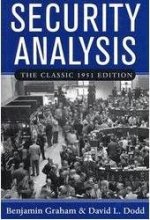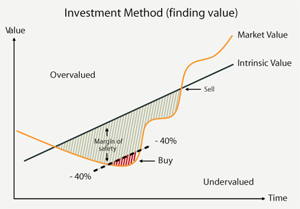Margin of Safety
 The world around us has many risks that we cannot control, so we plan accordingly. Essentially, you give yourself some room for error — or a margin of safety in the event something unexpected occurs or your assessment is overly optimistic. In the investment management process, there’s also a margin of safety. While the term may have many different connotations in finance, the most common usage occurs in security analysis, where it refers to the amount by which a security is priced (or “available for purchase”) below its intrinsic value.
The world around us has many risks that we cannot control, so we plan accordingly. Essentially, you give yourself some room for error — or a margin of safety in the event something unexpected occurs or your assessment is overly optimistic. In the investment management process, there’s also a margin of safety. While the term may have many different connotations in finance, the most common usage occurs in security analysis, where it refers to the amount by which a security is priced (or “available for purchase”) below its intrinsic value.
"Price is what you pay -- Value is what you get", said Warren Buffett. Valuing a business is, therefore, a fundamental skill that every value investor must master to be able to discern the intrinsic value of a business. If you’ve already guessed this has something to do with value investing, you’re right. Benjamin Graham, who is often referred to as the father of value investing, first introduced the term in his 1934 book, Security Analysis, which he co-authored with David Dodd. He later revisited it in the much more readable The Intelligent Investor, published in 1949. Today, many well-known value investors, including Warren Buffett (“Berkshire Hathaway”), Mason Hawkins (“Southeastern Asset Management”), Seth Klarman (“The Baupost Group”), Glenn Greenberg (“Chieftain Capital”), Charles Brandes (“Brandes Investment Partners”), Robert Rodriguez (“FPA Capital”) and Joel Greenblatt (“Gotham Capital”) are advocates of the concept.
Intrinsic Value & Discounted Cash Flow
Let’s say you’re considering investing in a company’s common stock. You do your analysis to determine your assessment of its intrinsic value. You consider the company’s competitive position; the sustainability of its competitive advantages (if any); returns on invested capital; evaluate the experience of the company’s management; and research financial statements such as the income statement and balance sheet in order to determine the company’s historical performance and present financial condition.
Your analysis would attempt to answer one key question; “What are the net present value of this businesses future cash flows worth?” In Theory of Investment Value, John Burr Williams was among the first to introduce the concept of a discounted cash flow (“DCF”) analysis. DCF basically calculates the present value of all future cash flows by applying a discount rate.
Margin of Safety
Finally, you decide the business is worth $10 per share. It is available for purchase at $9 per share -- providing a 10% margin of safety. That’s a good deal, right? Maybe. But what if your assessment of the company’s intrinsic value was incorrect? Or an unforeseen event seriously and permanently impairs the ability of the business to generate profits at previous levels? And then the stock price falls to $7 per share after you buy it? In that case, a 10% margin of safety simply wasn’t enough to allow for faulty judgment and the vagaries of the marketplace -- you needed at least a 30% margin of safety to avoid losing money. The point is, regardless of how well you analyze a specific company -- your assessment could be wrong, business conditions can deteriorate or financial markets can move violently downward over the short-term.
How large of a margin of safety did Graham recommend -- enough to allow for all possibilities. Unfortunately, that’s not an exact number. For example, Graham recommended that investors look for companies that trade at less than 67% of their net current asset value per share. Net current asset value per share is calculated by subtracting a company’s total liabilities from its total assets and dividing that number by the total number of outstanding shares.
Buying a Dollar for 60 cents
In practice, investors (and value-oriented investment managers) are attempting to acquire assets at a significant discount from their assessment of intrinsic value – often stated is a 40% discount from intrinsic value or a “dollar for 60 cents”. Further, many successful investment advisors are looking for a catalyst which will cause the price of the security to reach its fair value. Others view the discount from fair value as the only catalyst necessary with the belief that the market will naturally correct this gross undervaluation.

To start, the necessary margin of safety might fluctuate with market conditions. Let’s be blunt, in an overheated heated bull market, an investor who demands a 30-40% margin of safety may not find many candidates for investment – and that is to be expected. Investors (or investment managers) should expect “absolute” value regardless of the whims of financial markets. Often times, many of the most successful value investors and managers let their cash balances build if no suitable investment opportunities can be identified. (Many of the managers noted at the outset of this article had large cash balances at the height of the market in 2007 before the harrowing downturn in 2008.)
It might depend on the transparency and reliability of the information that’s available about the company you are evaluating. Some investors may require a smaller margin of safety with domestic companies than with those in an emerging market – or more reliable businesses could demand a lower margin of safety than more cyclical or leveraged companies.
Approximately Right
Moreover, the necessary margin of safety might fluctuate with the so-called “risk free rate of return,” which typically refers to the yield of U.S. Treasuries. If you can get a relatively risk-free investment whose yield is fairly high—say, 12%—you may demand a larger margin of safety from riskier investments such as stocks (because if the difference was small, you’d just buy the relatively risk-free investment). On the other hand, if the best yield you can obtain on a relatively risk-free investment is 3%, you may demand a lower margin of safety from stocks. In general, Graham liked companies that offered an earnings yield of at least 5% more than the yield of long-term corporate bonds.
“Margin of Safety” is one of the most important concepts to understand and implement as you build your investment portfolio. As Warren Buffet once reportedly said, “It is better to be approximately right than precisely wrong.”



